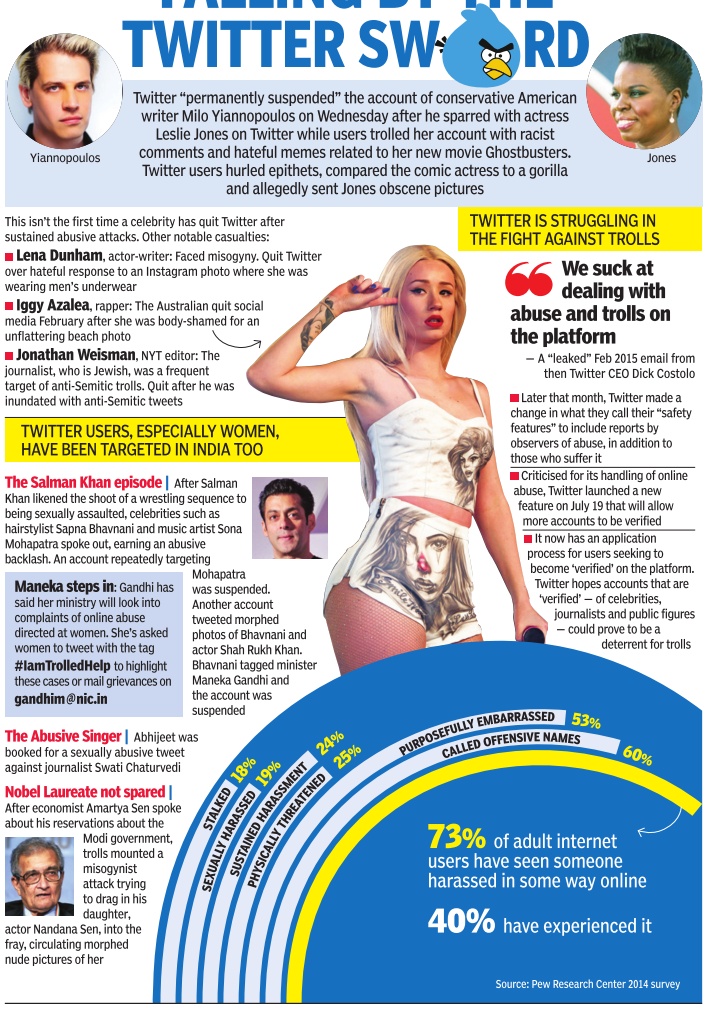X/ Twitter and India
(→“GOI forced its agent on Twitter payroll”) |
(→Blocking prominent accounts) |
||
| Line 121: | Line 121: | ||
The minister said there will be “no compromise” in ensuring that Twitter adheres to the new IT rules. | The minister said there will be “no compromise” in ensuring that Twitter adheres to the new IT rules. | ||
| − | [[Category:Culture & Learning|T TWITTER AND INDIATWITTER AND INDIA | + | =Court judgments= |
| + | ==2023: Costs imposed by Karnataka High Court== | ||
| + | [https://epaper.timesgroup.com/article-share?article=01_07_2023_001_011_cap_TOI July 1, 2023: ''The Times of India''] | ||
| + | |||
| + | Bengaluru : In a setback to Twitter Inc, the Karnataka high court dismissed the US-based microblogging platform’s petition challenging a series of blocking orders issued to it by the Centre from Feb 2, 2021 to Feb 28, 2022, reports Vasantha Kumar. | ||
| + |
Noting that the petitioner had indulged in speculative litigation, Justice Krishna S Dixit imposed Rs 50 lakh as exemplary costs on Twitter. | ||
| + |
Twitter had claimed in its petition that the blocking orders were “arbitrary” as they failed to provide prior notice to the content originator. It also argued that they were “unconstitutional” as they did not meet the requirements under Sec 69A of the IT Act. | ||
| + | |||
| + | ===Details=== | ||
| + | [https://epaper.timesgroup.com/article-share?article=01_07_2023_026_012_cap_TOI Vasantha Kumar, July 1, 2023: ''The Times of India''] | ||
| + | |||
| + | |||
| + | Bengaluru : “The petitioner is not a poor farmer, a menial labourer, a villager or a novice who could have pleaded his inability to understand the objectionability of the tweets and evidentiary material vouching such objection,” the Karnataka HC said, rejecting Twitter’s contention that it had not got sufficient opportunity for representat ion. Twitter had argued that the g overnment’s orders to take down content between Feb 2, 2021 and Feb 28, 2022 were “arbitrary” and “unconstitutional”. | ||
| + | |||
| + |
Imposing Rs 50 lakh as ex emplary costs on Twitter, Justice Krishna S Dixit said the amount is payable to the Karnataka State Legal Services Authority within 45 days, failing which the petitioner will have to pay an additional Rs 5,000 per day.
Twitter “is a multinational IT company whose annual revenue generation is about $5 billion, as submitted by the learned ASG. It has technical team s having expertise in the matter relating to law and procedure of website blocking not only in India but in other parts of the globe too,” the judge observed. “Its representatives, who admittedly participated in several meetings of the committee, never indicated to authorities the grievances now being aired. ” | ||
| + | |||
| + |
Twitter had claimed the blocking orders were “unconstitutional” and in violation of the In formation Technology Act’s Section 69-A (power to issue directions for blocking for public access of any information through any computer resource).
| ||
| + | |||
| + | Justice Dixit noted that the central government h ad offered a plausible explanation as to why it had resorted to the extreme measure of blocking accounts in respect of a few users/originators. | ||
| + | |||
| + |
“There were repetitive posts and some originators had behavioural antecedents of repetitive posting or potential and their highly objectionable tweets had a great propensity to incite anti-national feelings,” the judge said. “Fairness was exhibited by removing the blockage of 10 of the 11 accounts at a meeting held on June 30, 2022,” he added. “I am of the considered opinion that the power to block under Section 69 A(1) of the IT Act, read with the Website Blocking Rules, is not tweet-specific but extends to user accounts in their entirety,” the judge explained. | ||
| + | |||
| + |
The petitioner, being an intermediary, cannot invoke Rule 8(1) of Website Blocking Rules as a launchpad for its complaints when, apparently, the said rule was promulgated to protect the interests of only the account users and not others, the judge said. “There is a wilful noncompliance with the blocking orders,” Justice Dixit said. | ||
| + | |||
| + | [[Category:Culture & Learning|T TWITTER AND INDIATWITTER AND INDIATWITTER AND INDIA | ||
TWITTER AND INDIA]] | TWITTER AND INDIA]] | ||
| − | [[Category:Economy-Industry-Resources|T TWITTER AND INDIATWITTER AND INDIA | + | [[Category:Economy-Industry-Resources|T TWITTER AND INDIATWITTER AND INDIATWITTER AND INDIA |
TWITTER AND INDIA]] | TWITTER AND INDIA]] | ||
| − | [[Category:India|T TWITTER AND INDIATWITTER AND INDIA | + | [[Category:India|T TWITTER AND INDIATWITTER AND INDIATWITTER AND INDIA |
TWITTER AND INDIA]] | TWITTER AND INDIA]] | ||
| − | [[Category:Pages with broken file links|TWITTER AND INDIATWITTER AND INDIATWITTER AND INDIATWITTER AND INDIA | + | [[Category:Pages with broken file links|TWITTER AND INDIATWITTER AND INDIATWITTER AND INDIATWITTER AND INDIATWITTER AND INDIA |
TWITTER AND INDIA]] | TWITTER AND INDIA]] | ||
Revision as of 06:37, 7 July 2023
This is a collection of articles archived for the excellence of their content. |
Contents |
Controversies
2021: Manipulated media’
Anam Ajmal , May 25, 2021: The Times of India
Just as the news of Delhi Police special cell team visiting Twitter’s office broke on social media, the hashtag Manipulated Media became one of the top trends with over 17k posts. But what does the label recently slapped on a bunch of BJP politicians, notably Sambit Patra, by Twitter mean? TOI takes a look at the tag that has led to another round of standoff between Twitter and the union government:
What is manipulated media?
Twitter defines any media (videos, audio, and images) that have been deceptively altered or fabricated as manipulated. Tweets are labeled under this category when they are “likely to cause harm”.
How does Twitter tag content as manipulated?
Twitter says it uses a mix of technology and expert human review to label content. “In order to determine if media have been significantly and deceptively altered or fabricated, we may use our own technology or receive reports through partnerships with third parties,” the company has explained in a blog.
What action does Twitter take against manipulated content?
Depending on the severity of the fabrication and the likely harm it can cause, Twitter either labels content or removes them from the platform. The company also reduces visibility of such content, and warns users that “repeated violations” can lead to their accounts being permanently suspended.
“GOI forced its agent on Twitter payroll”
The Times of India, 24 August 2022
GOI forced Twitter to put its agent on payroll: Report
Twitter’s former security chief Peiter Zatko has alleged that the Indian government forced it to put its agent on the payroll, according to a whistleblower disclosure with US regulators. Zatko raised the issue with the US SEC, said a Reuters report. Zatco said the agent would have had access to sensitive user data due to Twitter’s weak security infrastructure. IT ministry officials did not respond to requests for comments. Twitter rubbished Zatko’s claims.
India threatened to shut down Twitter: Dorsey; govt denies
Soumyarendra Barik, June 14, 2023: The Indian Express
Twitter’s co-founder and former boss Jack Dorsey has reiterated that the platform received “many requests” from the Indian government to block accounts covering farmers’ protests and those critical of the government. He has also said that the platform was threatened with “a shut down” and conducting raids at its employees’ homes in the country.
Minister of State for Electronics and IT Rajeev Chandrasekhar responded to Dorsey’s claims, saying that under him, Twitter was in “repeated and continuous violations of India law” and at times “weaponised misinformation”.
It is worth noting that Twitter’s new CEO Elon Musk also has a similar view of India’s social media regulations, having previously called them “strict”. In April this year, Musk had said that he would rather comply with the government’s blocking orders than risk sending Twitter employees to jail.
Musk was possibly referring to India’s Information Technology Rules, 2021, under which a senior representative of social media companies – called the chief compliance officer – can be potentially jailed for violating the norms.
‘We will shut you down if you don’t follow suit’
During an interview late Monday night to YouTube channel Breaking Points, when asked about the pressures he had received from foreign governments during his time as CEO of Twitter, Dorsey said, “India is a country that had many request of us around the farmers protest, around particular journalists that were critical of the government, and it manifested in ways such as ‘we will shut Twitter down in India,’ which is a very large market for us; ‘we will raid the homes of your employees,’ which they did; ‘we will shut down your offices, if you don’t follow suit,’ and this is India, a democratic country”.
At the height of the farmers’ protest in the country in 2021, the Centre had asked Twitter to take down nearly 1,200 accounts for alleged “Khalistan” links. Before that, it had asked the platform to take down more than 250 accounts.
Twitter had responded by blocking some of the accounts but subsequently unblocked them, which had irked the IT ministry. Later in its reply, Twitter had refused to block these accounts further citing freedom of speech on its platform. The reply, however, had not gone down well with the Government, which had said that the platform could not possibly “assume the role of a court and justify non-compliance”.
In May 2021, days after Twitter flagged some posts by ruling party leaders alleging a Congress plot to malign the Prime Minister and the Central Government as “manipulated media”, a team of Delhi Police’s Special Cell — working under the Union Home Ministry — knocked on the doors of Twitter India’s Delhi and Gurgaon offices to ostensibly serve the social media platform a notice.
‘Outright lie’ by Dorsey: MoS IT Rajeev Chandrasekhar
Reacting to Dorsey’s claims, Chandrasekhar said that no one from Twitter went to jail nor was the platform “shutdown” despite the fact that they were in “non-compliance with law repeatedly from 2020 to 2022 and it was only in June 2022 when they finally complied”.
“Dorsey’s Twitter regime had a problem accepting the sovereignty of Indian law. It behaved as if the laws of India did not apply to it,” Chandrasekhar said. “India as a sovereign nation has the right to ensure that its laws are followed by all companies operating in India.”
He added that the Centre was “obligated” to issue takedown orders during the farmers’ protest in 2021 since there was “a lot of misinformation and reports of genocide which were definitely fake”.
“Such was the level of partisan behaviour on Twitter under Jack’s regime, that they had a problem removing misinformation from the platform in India, when they did it themselves when similar events took place in the USA,” he said.
Growing trend of online censorship
There has been a significant surge in legal demands being made by India — from various courts and the government — to remove content from Twitter between 2014 and 2020, an analysis of Twitter’s global transparency reports by The Indian Express had earlier shown. Incidentally, in the same time period, the number of content blocking orders issued to social media companies by the government has also increased by almost 2,000 per cent, data shared with Parliament showed, highlighting the growing trend of online censorship in India.
In the first six months of 2021, Twitter was asked by various Indian courts and the government to block a little more than 4,900 tweets — this coincided with the company blocking more than 250 accounts in relation to sharing “provocative” tweets over the then ongoing farmers’ protests and the company receiving orders from the government to take down some tweets critical of the government’s handling of Covid-19.
Twitter suing the Centre
In July 2022, Twitter initiated legal action against some of the government missives ordering it to take down certain content posted on the microblogging site. Alleging disproportionate use of power by officials, the social media company moved the Karnataka High Court Tuesday against the Ministry’s content-blocking orders issued under Section 69 (A) of the Information Technology Act, 2000.
Blocking prominent accounts
As in 2021 June
Pankaj Doval, June 26, 2021: The Times of India
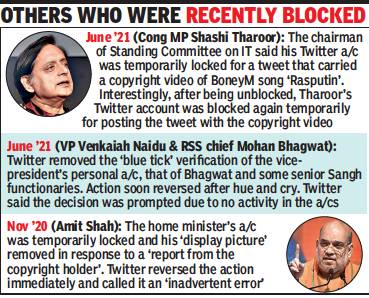
From: Pankaj Doval, June 26, 2021: The Times of India

From: Pankaj Doval, June 26, 2021: The Times of India
At a time when it is in the thick of the storm around its reluctance to follow India’s new IT rules, Twitter was embroiled in a fresh controversy and embarrassment on Friday after IT and law minister Ravi Shankar Prasad revealed that his account was blocked for nearly an hour over alleged violation of an American copyright law due to one of his tweets.
The minister linked the action by the global microblogging giant to his tough stand against the company over non-compliance with the new rules. “Twitter’s actions indicate that they are not the harbinger of free speech that they claim to be but are only interested in running their own agenda, with the threat that if you do not tow the line they draw, they will arbitrarily remove you from their platform,” Prasad said in a series of tweets.
It later emerged, through the Lumen database of Harvard University, that Prasad’s tweet that resulted in the action was from December 2017. He had tagged music composer AR Rahman’s ‘Maa Tujhe Salaam’ video, while writing about India’s 1971 victory over Pakistan. The video, according to Twitter, violated copyright laws after there was a complaint to this effect.
What is, however, still unclear is why the company had taken the action after nearly three and a half years, especially when it is embroiled in a bitter exchange with the government over the new IT rules. Also, why the minister’s account was restored after just an hour it was indeed deemed to have violated an American law.
Prasad alleged the action and “agenda” by Twitter was the result of the government’s “no compromise” stand against the company after it failed to comply with the new rules.
It’s apparent why Twitter is refusing to comply: Prasad
The non-compliance has seen Prasad’s IT ministry reprimand Twitter over the past few weeks, while the company also lost its ‘safe harbour’ protection over third-party content, just when an FIR was filed against its India MD in relation to a probe by Ghaziabad Police.
When contacted about the action against Prasad’s account, a spokesperson for Twitter said, “We can confirm that the minister’s account access was temporarily restricted due to a DMCA notice only and the referenced tweet has been withheld. Per our copyright policy, we respond to valid copyright complaints sent to us by a copyright owner or their authorised representatives.”
Prasad, who voluntarily disclosed Twitter’s action, ironically on Twitter, and its local rival Koo, at 3.42pm, claimed that the “highly peculiar” action showed that Twitter is against carriage of free speech, and is interested in running its own “agenda”. The minister, who advocated action against the company as he wasn’t served prior notice, carried screenshots of the email communication that he had received from Twitter during the blocking, and unblocking, but this didn’t have any timeline and dates.
He said the company’s actions were in “gross violation” of Rule 4(8) of the IT Rules, 2021. “It’s apparent that my statements calling out the high handedness and arbitrary actions of Twitter, particularly sharing the clips of my interviews to TV channels and its powerful impact, have clearly ruffled its feathers. It is apparent as to why Twitter is refusing to comply with intermediary norms because if Twitter complies, it would be unable to arbitrarily deny access to an individual’s account which doesn’t suit their agenda,” the minister said.
The minister said there will be “no compromise” in ensuring that Twitter adheres to the new IT rules.
Court judgments
2023: Costs imposed by Karnataka High Court
July 1, 2023: The Times of India
Bengaluru : In a setback to Twitter Inc, the Karnataka high court dismissed the US-based microblogging platform’s petition challenging a series of blocking orders issued to it by the Centre from Feb 2, 2021 to Feb 28, 2022, reports Vasantha Kumar. Noting that the petitioner had indulged in speculative litigation, Justice Krishna S Dixit imposed Rs 50 lakh as exemplary costs on Twitter. Twitter had claimed in its petition that the blocking orders were “arbitrary” as they failed to provide prior notice to the content originator. It also argued that they were “unconstitutional” as they did not meet the requirements under Sec 69A of the IT Act.
Details
Vasantha Kumar, July 1, 2023: The Times of India
Bengaluru : “The petitioner is not a poor farmer, a menial labourer, a villager or a novice who could have pleaded his inability to understand the objectionability of the tweets and evidentiary material vouching such objection,” the Karnataka HC said, rejecting Twitter’s contention that it had not got sufficient opportunity for representat ion. Twitter had argued that the g overnment’s orders to take down content between Feb 2, 2021 and Feb 28, 2022 were “arbitrary” and “unconstitutional”.
Imposing Rs 50 lakh as ex emplary costs on Twitter, Justice Krishna S Dixit said the amount is payable to the Karnataka State Legal Services Authority within 45 days, failing which the petitioner will have to pay an additional Rs 5,000 per day. Twitter “is a multinational IT company whose annual revenue generation is about $5 billion, as submitted by the learned ASG. It has technical team s having expertise in the matter relating to law and procedure of website blocking not only in India but in other parts of the globe too,” the judge observed. “Its representatives, who admittedly participated in several meetings of the committee, never indicated to authorities the grievances now being aired. ”
Twitter had claimed the blocking orders were “unconstitutional” and in violation of the In formation Technology Act’s Section 69-A (power to issue directions for blocking for public access of any information through any computer resource).
Justice Dixit noted that the central government h ad offered a plausible explanation as to why it had resorted to the extreme measure of blocking accounts in respect of a few users/originators.
“There were repetitive posts and some originators had behavioural antecedents of repetitive posting or potential and their highly objectionable tweets had a great propensity to incite anti-national feelings,” the judge said. “Fairness was exhibited by removing the blockage of 10 of the 11 accounts at a meeting held on June 30, 2022,” he added. “I am of the considered opinion that the power to block under Section 69 A(1) of the IT Act, read with the Website Blocking Rules, is not tweet-specific but extends to user accounts in their entirety,” the judge explained.
The petitioner, being an intermediary, cannot invoke Rule 8(1) of Website Blocking Rules as a launchpad for its complaints when, apparently, the said rule was promulgated to protect the interests of only the account users and not others, the judge said. “There is a wilful noncompliance with the blocking orders,” Justice Dixit said.
Government requests
2012-17: Content removal
India has shown a steady increase in the number of account information and content removal requests sent to Twitter from the government since 2012, with the maximum number of requests made between January and June 2017.
India made 104 requests for content removal and another 261 requests for account information. It was the sixth largest number of requests for account information after the US, Japan, the UK, Turkey and France. Twitter released these numbers in its half-yearly transparency report.
Twitter fulfilled 21% of the 261 account information requ ests India made. These requests covered 659 accounts. This number was up from 168 requests made in July-December 2016, where 427 accounts were specified. Although the number of requests has been lower in previous years, the number of accounts has been significantly higher before.
“These fluctuations and rise in numbers is tough to ascribe to any one factor. It could be because of more people using the service, or because of the government starting to recognise Twitter and social media as places where a law and order problem can occur, or it could be censorship,“ says Parminder Jeet Singh, executive director for Bengaluru-based NGO IT for Change.
2015-18: requests for user data
Digbijay Mishra, Govt requests for info from Twitter surge, December 15, 2018: The Times of India
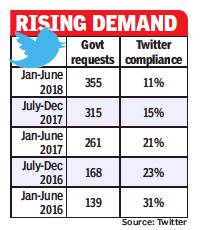
From: Digbijay Mishra, Govt requests for info from Twitter surge, December 15, 2018: The Times of India
The Indian government wants to know more about what you do on Twitter and its curiosity is only growing. The Centre’s requests from Twitter for user data has risen by over 100% in the last two years, as per the latest transparency report released by the social media major. Between January and June 2018, India sought information on 355 accounts, up from 261 and 139 in the first six months of 2017 and 2016 respectively. Twitter’s transparency data shows that the numbers every six months have been rising.
However, Twitter provided information in the case of only 11% of the requests made by the government in the first six months of 2018. It got 246 requests for removal of accounts in this period and obliged to only about 5% of them. Twitter’s rate of acceptance of government requests has fallen sharply, from 31% in the first half of 2016, to 11% in the latest period. Indian authorities (government, police, court orders) sought to remove 144 accounts in the second half of 2017, and 104 in the first half of that year.
The data showed Twitter withheld (prevented access to) two accounts and 23 tweets in response to a legal demand from the IT ministry for propagating objectionable content. Following legal requests, a total of 19 accounts and 498 tweets were withheld.
The past few years have seen increasingly harsh, often incendiary, posts on social media. More Indians have also flocked to Twitter to air their views. The rising requests from the government is partly a reflection of its attempt to control the more inflammatory posts. When demands are made legally, based on the laws of the land, social media companies are obliged to respect the demand. In other cases, they need to take into account whether accepting the government request would amount to violating the freedom of expression of the user.
In India, between 2012 and 2014, the government sent less than 100 requests for information. But in the first six months of 2015 alone, over 100 requests were made.
India is said to have about 30 million Twitter users, as per estimates by market research firm Statista.
Globally too, government requests have been rising. Twitter said that in the first half of the year, it received 10% more government information requests worldwide, compared to the preceding six-month period — the largest percentage increase since 2015. There was also an 80% rise in global legal demands for removal of accounts in the first six months, compared to the preceding sixmonth period. Close to 90% of these requests came from Russia and Turkey.
2021: Twitter blocks 97% handles on govt list
Pankaj Doval, February 12, 2021: The Times of India
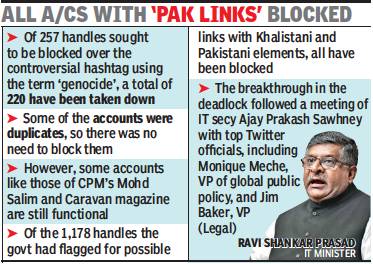
From: Pankaj Doval, February 12, 2021: The Times of India
There were signs of a thaw in Twitter’s tussle with the government after the social media giant took down over 97% of the handles that the IT ministry had sought to be censured for carrying “inflammatory content” related to ‘farmers’ genocide’ hashtag and accounts backed by Khalistan sympathisers and Pakistan.
Of the 1,435 handles flagged by the government through two separate requests, 1,398 have been taken down, top sources said.
The breakthrough in the deadlock came after IT secretary Ajay Prakash Sawhney’s meeting with Twitter executives Monique Meche and Jim Baker late Wednesday evening, following which the American social media giant started to act against the users.
“The compliance has come in for almost the entire list of accounts that we had asked to be taken down. For the remaining, Twitter has said that it is following the due process, which includes sending notice to the users and other such steps,” a government source told TOI.
‘A positive step by Twitter’
All the 1,178 handles that the government had flagged for possible links with Khalistani and Pakistani elements have been blocked.
Of the 257 handles that were sought to be blocked over the controversial hashtag, 220 have been taken down. “Some of the accounts could be duplicates,” the source said. However, some accounts such as that of CPM leader Mohammed Salim (@salimdotcomrade) and Caravan magazine (@thecaravanindia) remain functional. “We view this as a positive step that Twitter has taken. It does follow from the meaningful and healthy conversations that we had with the global executives of the company,” the government source said.
A spokesperson for Twitter in India did not respond to a questionnaire from TOI.
While the social media platform had earlier refused to comply with the government’s requests, on Wednesday, the IT secretary expressed displeasure over “differential treatment”.
“They must be obeyed immediately. If they are executed days later, it becomes meaningless,” IT Sawhney said. He also made it clear that the use of the controversial hashtag was neither journalistic freedom nor freedom of expression as such “irresponsible content could provoke and inflame” the situation.
Sources said that during the meeting, Baker, Twitter’s VP for legal matters, assured government representatives that the company would be mindful of the concerns. “Baker said that the global management of Twitter can be approached directly in case of violations that are sensitive in nature. This is seen as a massive reassurance to tackle hate, inflammatory and irresponsible messaging,” the source said.
The misuse of Twitter
2014
See graphic :
2014:The misuse of Twitter in India and the world, and action taken
The usage of Twitter
2016: The emoji tweeted most often

The Times of India
See graphic :
The emoji tweeted most often, India and the world, 2016
2019: politicians, their parties and their gender
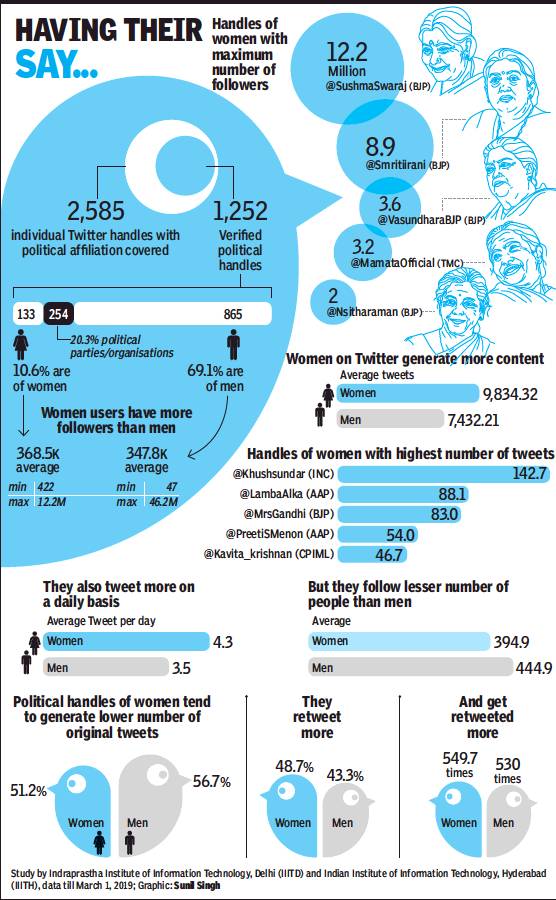
From: Mohammad Ibrar, Get a handle on this: Women calling poll shots on Twitter, March 21, 2019: The Times of India
It is politically prudent perhaps to give women their place in politics. After all, as research with Twitter data shows, handles of women on the platform have more followers on average than men and these handles also generate more content than men do. And even if the handles of women produce less original content, their retweets and engagement are high on Twitter, making them an asset for political parties especially in the coming general elections.
Admittedly, of the 1,252 verified political handles analysed, only 133 belonged to female political activists, the rest being those of male politicians or party handles. Analysed and studied at Indraprastha Institute of Information Technology (IIIT) Delhi and International Institute of Information Technology, Hyderabad, by a team of eight students as part of the focus on the 2019 Lok Sabha polls, these were culled after going through “over 21 million posts by roughly a million handles collected from the 2014 general elections”.
Ponnurangam Kumaraguru, associate professor at both IIITs, said he and his team of researchers covered data of over 2,585 Twitter handles which showed some sort of affiliation to an Indian political party. “This list was manually curated and we have been collecting data for these handles from late 2018 through the Twitter Application Programming Interface (API).”
On March 12, Trinamool Congress announced a list of candidates for West Bengal that had over 40% women. Similarly, Biju Janata Dal has said 33% of its candidates in Odisha will be women. A push of this nature is reflective of the increasing female participation on social media. On Twitter, for instance, the study showed that on average, women’s handles had 36,85,000 followers, with the minimum at 422 and the maximum of 12.2 million for external affairs minister Sushma Swaraj.
On average, the feminine handles generated 9,834 tweets each. Compare that with the 7,432 by their male counterparts. This is despite handles belong to men numbering 865, or 69.1%, of the 1,252 verified political handles. A majority of the female tweeters showed their origin to be in Maharashtra, Delhi and UP, the hotbed of political activism.
Social media will be a distinct factor in this election, felt Kumaraguru, and women politicians appeared to have a lot of clout on social media. “Gender diversity is a universal topic, and we find interesting patterns like female handles re-tweeting more,” said Kumaraguru. “Tweets by females on average get retweeted more than those by men — 550 times compared with 530 times for tweets by males.”
2021: What Indian women tweeted about
Shobita Dhar, Passions & pursuits: What Indian women tweet about, March 7, 2021: The Times of India
What do Indian women talk about on twitter? “Passions and pursuits” is the most discussed topic of conversation, with 25% of all women users coming on to Twitter to seek and consume this content. Out of this 25%, the majority (30%) seek content on fashion, 28% on books, 25% on beauty, 21% on movies and TV and 14% on sports. Over 40% of women said they discovered a new interest on Twitter.
‘Current affairs’ is the second most searched and consumed content, with 21% of all women users using Twitter to know what’s going on around them. Women from Delhi and Guwahati led this segment. About 21% use Twitter to stay informed on local and international news. Tweets about #StudentExams, #COVID19 related updates and #DelhiElections2020 dominated the conversation in this category.
These are findings from a research commissioned by Twitter India ahead of International Women’s Day. For the report, a qualitative curation and analysis of 5,22,992 tweets sent from Twitter accounts of women between January 2019 and February 2021 in 10 Indian cities was done. The majority of women, 33%, use Twitter while commuting; 29% catch up on the latest tweets during breakfast and 22% don’t go to bed without looking it up. Although Twitter doesn’t have data on how many women users it has in India, their research found that almost 9% use it to create and participate in social movements like #MeToo and #TimesUp.
While Twitter can often be a toxic place for women with many journalists, celebrities and politicians often receiving abuse and even rape threats on it, this doesn’t deter women from using the platform. About 40% said it provides them with freedom of expression.
About 12% used the platform to connect and network with others in their communities, like #WomenInScience and #GirlGamers. Women from Chennai, Bengaluru and Hyderabad were especially found to be active in this category. Nearly 7% women used Twitter to share and talk about everyday hardships like #Parenting, #WorkingFromHome.
“We commissioned this research to build our understanding about women on Twitter. Access to a free and open internet has made it possible for everyone to express themselves freely without barriers,” said Manish Maheshwari, managing director, Twitter India. While 41% of women have sought advice/tips/recommendations on the service, 37% have given advice/tips/recommendations.
The most followed Indians
As in 2020
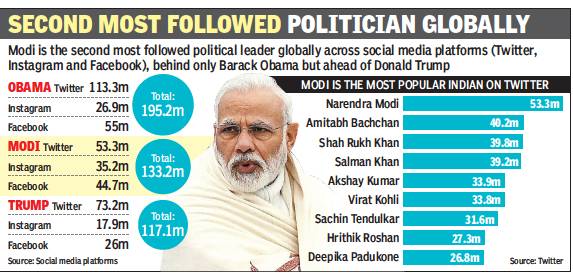
From: March 3, 2020: The Times of India
See graphic:
The Indians most followed on Twitter, presumably as in 2020 Feb
YEAR WISE DEVELOPMENTS
2021
Aug: Twitter transfers its India director to US
Pankaj Doval, August 14, 2021: The Times of India
Amidst serious legal and regulatory troubles in India, American micro-blogging giant Twitter has transferred its country director for India, Manish Maheshwari, to San Francisco in a new role and has done away with the post, forming a “leadership council” to run its operations in the country.
Senior functionaries—Kanika Mittal and Neha Sharma Katyal—will continue to lead the India sales roles and now report to Yu Sasamoto, vice-president for the company’s Japan, South Korea and Asia-Pacific (JAPAC) region. Maheshwari, who was head of Twitter India for two years, will now take charge of “revenue strategy and operations” for new markets globally.
Does Twitter India head need to tackle cases before US shift?
This caps a tumultuous tenure in the country where Manish Maheshwari saw multiple FIRs and police cases being filed against him over a variety of legal issues following the rollout of new IT Rules.
It is not yet clear whether he can simply walk out of the country to take up the new assignment or whether he would first need to tackle the legal and IPC cases where he has been named as a party/accused along with Twitter. Asked about the issue, Twitter India refused comment.
Twitter has decided that instead of a country director, a leadership council will guide its operations in India. This council is likely to have personnel like Kanika Mittal (responsible for leading Twitter’s business in north and east India) and Neha Sharma Katyal (who heads western and southern region businesses). Amongst other members Krishna Iyer — who is the head of channel sales for Twitter India — will report to global business partners and Mitchell Kreuch, who leads APAC “agency development” function.
“Instead of a single country director, India leadership council will guide you all as a team moving forward,” a Twitter official said in a communication to India team members, adding the company will “continue to invest in India as a high-growth market for our company.”
‘Twitter interfering in our pol process’
Congress MP Rahul Gandhi accused Twitter of “interfering” in India’s political process and making it company’s business “to define our politics”. Rahul said Twitter’s move to lock his account was not only “patently unfair”, but also “breaching the idea that Twitter is a neutral platform”.
